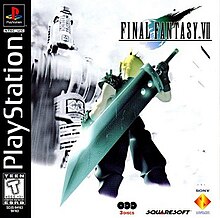
Back فاينل فانتسي 7 Arabic فاينل فانتسى 7 ARZ Final Fantasy VII AST Final Fantasy VII Bulgarian Final Fantasy VII Catalan Final Fantasy VII Czech Final Fantasy VII Danish Final Fantasy VII German Final Fantasy VII Greek Final Fantasy VII Esperanto
| Final Fantasy VII | |
|---|---|
 North American cover art, featuring the game's protagonist, Cloud Strife | |
| Developer(s) | Square |
| Publisher(s) |
|
| Director(s) | Yoshinori Kitase |
| Producer(s) | Hironobu Sakaguchi |
| Programmer(s) | Ken Narita |
| Artist(s) | |
| Writer(s) | Yoshinori Kitase Kazushige Nojima |
| Composer(s) | Nobuo Uematsu |
| Series | Final Fantasy |
| Platform(s) | |
| Release | January 31, 1997 |
| Genre(s) | Role-playing |
| Mode(s) | Single-player |
Final Fantasy VII[a] is a 1997 role-playing video game developed by Square for the PlayStation console and the seventh main installment in the Final Fantasy series. Square published the game in Japan, and it was released in other regions by Sony Computer Entertainment, becoming the first game in the main series to have a PAL release. The game's story follows Cloud Strife, a mercenary who joins an eco-terrorist organization to stop a world-controlling megacorporation from using the planet's life essence as an energy source. Ensuing events send Cloud and his allies in pursuit of Sephiroth, a superhuman who seeks to wound the planet and harness its healing power in order to be reborn as a god. Throughout their journey, Cloud bonds with his party members, including Aerith Gainsborough, who holds the secret to saving their world.
Development began in 1994, originally for the Super Nintendo Entertainment System. After delays and technical difficulties from experimenting with several platforms, most notably the Nintendo 64, Square moved production to the PlayStation, largely due to the advantages of the CD-ROM format. Veteran Final Fantasy staff returned, including series creator and producer Hironobu Sakaguchi, director Yoshinori Kitase, and composer Nobuo Uematsu. The title was the first in the series to use full motion video and 3D computer graphics, featuring 3D character models superimposed over 2D pre-rendered backgrounds. Although the gameplay remained mostly unchanged from previous entries, Final Fantasy VII introduced more widespread science fiction elements and a more realistic presentation. The combined development and marketing budget amounted to approximately US$80 million.
Final Fantasy VII received widespread commercial and critical success and remains widely regarded as a landmark title, and it is regarded as one of the greatest and most influential video games ever made. The title won numerous Game of the Year awards and was acknowledged for boosting the sales of the PlayStation and popularizing Japanese role-playing games worldwide. Critics praised its graphics, gameplay, music, and story, although some criticism was directed towards the original English localization. Its success has led to enhanced ports on various platforms, a multimedia subseries called the Compilation of Final Fantasy VII, and a high definition remake trilogy currently comprising Final Fantasy VII Remake (2020), and Final Fantasy VII Rebirth (2024).
Cite error: There are <ref group=lower-alpha> tags or {{efn}} templates on this page, but the references will not show without a {{reflist|group=lower-alpha}} template or {{notelist}} template (see the help page).
© MMXXIII Rich X Search. We shall prevail. All rights reserved. Rich X Search